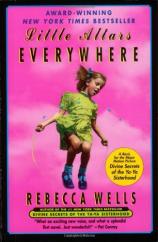Reading Group Guide
Discussion Questions
Little Altars Everywhere

1. Wells uses multiple narrators to unfold the story in Little Altars Everywhere. What advantages are gained by this? Does this multiple perspective mean that we sense the story from a broader perspective from that of any one character? And what, if any value, is that broader perspective when evaluating the moral behavior of a character? Does the use of multiple narrators point to a truth that is too big, too uncertain, and too complex for any one character or person to put all together into a cogent vision? Do multiple narrators soften our judgments about a character?
2. What attitude does the novel take toward institutional religion (i.e., denominations), spirituality (a belief in and need for God and meaning), and human suffering. Catholicism is a strong presence in the novel. How does Catholicism both bless and damage the Walker family?
3. Vivi imparts a complex legacy to her children. What are the ingredients of this legacy? Shame? Suffering? A sense of wonder? A capacity for rapture?
4. Wells has said that "humor is the healing art." Discuss this in light of this novel.
5. Wells opens the novel with references to Little Richard in the "Prologue" and to Aaron Neville in the concluding chapter? What significance might this have? What role does racism play in the story of the Walkers? How does the value system of Chaney and Willetta differ from that of Vivi and Shep?
6. At the end of the novel, Sidda has a moment of insight into both her life and the lives of her family when she suddenly realizes that, "All their longing was pure." What does Sidda mean by this expression?
7. How can the acceptance of suffering help transform that suffering into love?
Little Altars Everywhere
- Publication Date: May 22, 1996
- Paperback: 240 pages
- Publisher: Harper Paperbacks
- ISBN-10: 0060976845
- ISBN-13: 9780060976842








